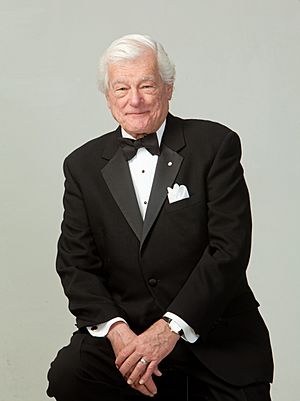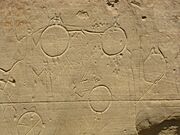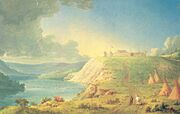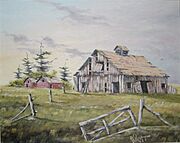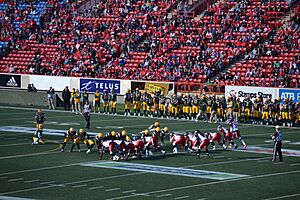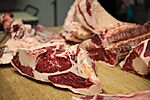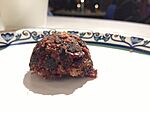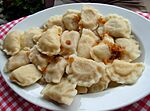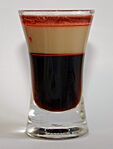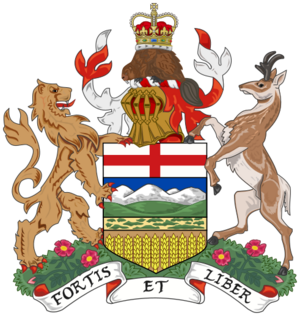Culture of Alberta facts for kids
The culture of Alberta is all about the art, customs, and traditions of the people who live in Alberta. Alberta became a province of Canada in 1905. Even though it's a younger province, it has a very rich culture.
Alberta's amazing landscapes, from towering mountains to wide-open prairies, have inspired many artists. Important jobs like farming, ranching, and the oil industry also play a big role in what makes Alberta special.
Contents
Arts
Architecture
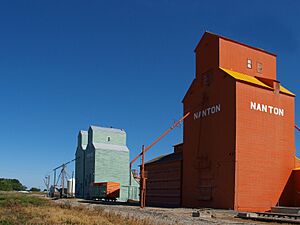
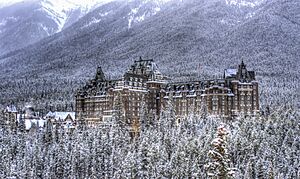
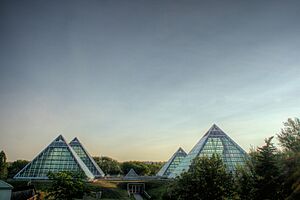
Not many buildings in Alberta were built before it became a province in 1905. In the early years, many important buildings were designed by companies from eastern Canada.
For much of the 1900s, wooden grain elevators were a common sight across Alberta. People called them "prairie sentinels" or "prairie cathedrals." These tall buildings were in most towns and became symbols of the Canadian prairies. Alberta's first grain elevator was built in Strathcona in 1895. These elevators, with town names painted on their sides, helped travelers find their way. By 1951, there were 1,651 elevators in Alberta. However, many were taken down over time, and by 2005, only 156 wooden ones remained. Some, like those in Andrew and St. Albert, are now protected as historical sites.
Alberta is also home to six grand hotels built by railway companies. Some of these are in the "château style," which looks like old French castles. These hotels include the Palliser Hotel, Hotel Macdonald, Banff Springs Hotel, Château Lake Louise, Jasper Park Lodge, and Prince of Wales Hotel. All of them are still popular places for tourists to visit.
After World War II, architects in Alberta started using the "International Style," which focused on simple, modern designs. Later, a new group of architects wanted to create a unique Albertan style that fit the province's landscape. One of the most famous of these was Douglas Cardinal, who became known worldwide for his work.
Two of the most famous buildings in Calgary's skyline are the Calgary Tower (built in 1968) and the Olympic Saddledome (built in 1983). In Edmonton, the Alberta Legislature Building (built in 1907) and the Muttart Conservatory (built in 1976) are very well-known.
Dance
Alberta has Canada's third-largest ballet company, the Alberta Ballet Company. It was started in 1958 by Ruth Carse. She was a ballerina who had to retire early due to an injury. The company first started in Edmonton and later moved to Calgary in 1990. It is now based in St. Mary's Parish Hall.
Film
During the "Golden Age of Hollywood," many movies about the North were set in Alberta. Some were filmed here, while others were shot in the United States. For example, the 1954 film River of No Return, starring Marilyn Monroe, was filmed in Banff, even though the story takes place in the U.S.
Alberta now has a growing film industry, mostly based in Calgary. In the past, Alberta's prairie landscapes made it a popular place to film western movies. These include famous films like Unforgiven (1992) and Brokeback Mountain (2005).
More recently, many successful movies have been filmed or set almost entirely in Alberta. These include Superman (parts II and III), The Revenant (2015), Ghostbusters (2020), and Inception (2010).
Music
Alberta has two professional orchestras: the Calgary Philharmonic Orchestra and the Edmonton Symphony Orchestra. Both were formed by combining earlier music groups. The Calgary Philharmonic now performs at the Jack Singer Concert Hall, and the Edmonton Symphony performs at the Winspear Centre.
Several well-known classical composers have lived in Alberta. Violet Archer moved to Edmonton in 1962 and often found inspiration in Alberta's landscapes. Other composers like Allan Gordon Bell and Allan Gilliland studied under her.
Alberta has a lively jazz music scene. The Yardbird Suite in Edmonton has been open since 1984, making it one of Canada's oldest jazz clubs. It hosts local, national, and international musicians. Two of Alberta's most famous jazz musicians are saxophonist P. J. Perry and pianist Tommy Banks. Tommy Banks was also a senator.
Country and western music is a big part of Alberta's music scene. Ian Tyson, though born in British Columbia, is one of Alberta's most famous country musicians. He lived on a ranch near Longview, Alberta, and sang many cowboy-themed songs. His song "Four Strong Winds" is one of Canada's most famous songs and talks about Alberta. Corb Lund and his band, The Hurtin' Albertans, also sing many songs about Alberta.
Many successful pop musicians and bands have come from Alberta. These include Jann Arden, k.d. Lang, Joni Mitchell, Feist, and bands like Loverboy and Nickelback.
The CKUA Radio Network is an important music station across the province. It started in 1927 and plays all kinds of music. It is supported by donations from listeners.
Painting
The first art in Alberta was made by Aboriginal tribes like the Blackfoot. They created pictographic art on tipis, rocks, and robes, often showing spiritual themes and tribal wars. A great example of this art can be seen at Writing-on-Stone Provincial Park.
The first European artist to visit Alberta was Paul Kane in the late 1840s. He loved the vast landscape and painted the West as a romantic and exciting place. Other early European artists also created romantic paintings of the land. They often used watercolors because they dried quickly and were easy to carry.
After the Canadian Pacific Railway was finished in 1885, the railway company gave free passes to artists. The paintings they created helped encourage people to travel to the new western regions. Many of these early paintings showed the mountains more than the prairies.
After World War I, Alberta artists started creating groups and schools to support their art. The first art classes were held in Calgary in 1921. The Banff School of Fine Arts also started art classes in 1935 and is still a very important art school today. All but two members of the famous Group of Seven painted in Alberta. A. Y. Jackson was the only one who painted both prairies and mountains. In the 1940s and 50s, a new generation of Aboriginal artists began to paint their communities using European art styles.
After the 1960s, modern art and abstract styles became very popular in Alberta. Many new art galleries opened, including the Walter Phillips Gallery and the Nickle Arts Museum. In 1975, a large collection of Alberta art was shown in London, England.
-
Fort Edmonton by Paul Kane (c. 1849-56)
Sport
Football
A big part of sports culture in Alberta is the "Battle of Alberta," which is the rivalry between teams from Edmonton and Calgary. This rivalry happens in many different sports.
Calgary and Edmonton football teams have played against each other since the 1890s. After World War II, the Calgary Stampeders and Edmonton Eskimos (now the Edmonton Elks) were formed. They quickly became rivals in the CFL West Division. Every year, these two teams play in the "Labour Day Classic," which is one of the most important annual sporting events in the province. This game is usually played in Calgary. A newer tradition is the "Labour Day Rematch," where Edmonton hosts Calgary the week after Labour Day.
In 1948, when the Calgary Stampeders played in their first Grey Cup, a large group of fans traveled to Toronto to support them. They even brought livestock and chuckwagons! Members of the Stampeders famously rode a horse into the lobby of the Royal York Hotel. This tradition of riding a horse into a hotel is something Calgarians still do when the Stampeders play in the Grey Cup.
Hockey
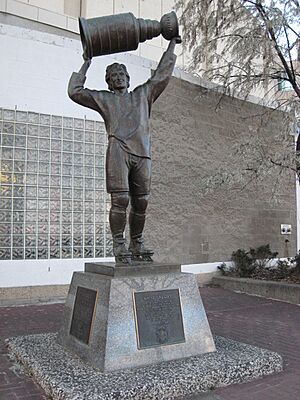
Calgary and Edmonton hockey teams have also been rivals since the 1890s. But the rivalry really grew in the 1980s when both cities had professional teams. The Edmonton Oilers joined the NHL in 1979. The Calgary Flames moved to Calgary in 1980 from Atlanta.
The "golden age" of the Flames-Oilers rivalry was in the late 1980s. Both teams were very strong and played exciting, tough games. From 1983 to 1990, either the Oilers or the Flames played in the Stanley Cup Finals every year. The greatest sports star in Alberta's history is without a doubt Wayne Gretzky, who played for the Edmonton Oilers from 1979 to 1988.
Junior hockey leagues, like the Western Hockey League, are also very important in Alberta's smaller towns.
Rodeo and chuckwagons
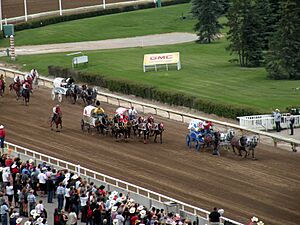
The first rodeo in Canada was held in Raymond, Alberta in 1902. The sport quickly became popular. In 1912, Guy Weadick and a group of businessmen known as the "Big Four" added the first Calgary Stampede to the Calgary Exhibition. The Stampede has happened every year since then and is Calgary's biggest tourist event. Alberta hosts most of the rodeos in the Canadian Professional Rodeo Association season. Other big rodeos include the Ponoka Stampede.
The sport of chuckwagon racing was invented by Guy Weadick. The first official races were held at the 1923 Calgary Stampede. Most chuckwagon races during the season take place in Alberta.
Skiing

Alberta is bordered by the Canadian Rockies to the west, which means it has some of the best skiing in the world. Many Albertans spend their winter weekends in the mountains. Major ski resorts include Sunshine Village, Lake Louise, Nakiska, Mount Norquay, and Marmot Basin. The alpine skiing events at the 1988 Winter Olympics were held at Nakiska. Calgary is home to Canada Olympic Park, which has a ski jump and bobsleigh track used in the 1988 Olympics.
Cuisine
Food
Alberta's ranches have over 40% of Canada's beef cattle. So, beef is one of the province's most famous foods! Hy's Steakhouse, a well-known restaurant, started in Calgary in 1955. Other famous steakhouses include the Longview Steakhouse.
Historically, most small towns in Alberta had a Chinese restaurant on their main street. Canadian-Chinese food is still very popular. The dish ginger beef was invented in Calgary in the 1970s. In central Alberta, where many people have Eastern European backgrounds, pierogies are a popular food. They are often served at Ukrainian churches and community halls. During Stampede week in Calgary, many communities host free pancake breakfasts to celebrate.
Some special foods from Alberta include honey, canola, Red Fife wheat, Saskatoon berries, and root vegetables. Alberta is the fifth-largest honey producer in the world, making half of Canada's total honey. Alberta honey is known for its white color and creamy texture. Canola, which stands for "Canadian oil," was developed in Alberta. Saskatoon berries are native to Alberta and are used in jams, pies, and historically, for tea and to make pemmican.
Drink
The oldest distillery in Alberta is Alberta Distillers, founded in 1946. Their most famous product is Alberta Premium, a whisky made from 100% rye grain. The cocktail "Bloody Caesar," or simply "Caesar," was invented in Calgary in 1969 by bartender Walter Chell. This drink has become one of the most popular cocktails in Canada.
Alberta's most famous beer is Old Style Pilsner, first brewed in 1926 in Lethbridge. While it's no longer brewed in Alberta, it's still a popular drink here. Another historic beer was Calgary Beer, first brewed in 1892. Its buffalo head logo was a well-known symbol of the city for many years. Newer Alberta breweries whose beers are popular include Big Rock Brewery and Wild Rose Brewery.
Alberta is also the origin of other well-known cocktails. The B-52 shot, invented at the Banff Springs Hotel, is a layered drink with coffee liqueur, Irish cream, and Grand Marnier.
Costume
Albertans often wear western wear for public events. In Calgary, many people wear cowboy hats and boots during Stampede week in July. Since 1950, Calgary has given its "White Hat" to important visitors when they arrive. The official maker of the Calgary White Hat is Smithbilt Hats, which has been making cowboy hats since 1919. Two major western wear stores, Riley and McCormick and Lammle's, also started in Alberta.
Symbols
Decorative symbols
Alberta's coat of arms was given by King Edward VII in 1907. It originally had a shield with a Saint George's Cross at the top, representing the Hudson's Bay Company. Below the cross, it shows a wheat field, a grass prairie, foothills, and the Rocky Mountains. In 1980, Queen Elizabeth II added more elements to the shield: a beaver (for Canada), a lion (for the monarchy), and a pronghorn antelope (for Alberta). The motto on the arms is "fortis et liber," which means "strong and free."
On June 1, 1968, Alberta adopted its official flag. The flag has the province's shield in the center on a blue background. Alberta also has two tartans, which are special plaid patterns. The regular tartan, adopted in 1961, has colors representing forests (green), wheat fields (gold), skies and lakes (blue), wild roses (pink), and coal and oil (black). The dress tartan, adopted in 2000, shows the Alberta landscape in winter.
Natural symbols

Alberta's most famous natural symbol is the wild rose. The province's license plates even say "Wild Rose Country," showing how important the flower is. Alberta's provincial tree is the lodgepole pine, its provincial mammal is the bighorn sheep, and its provincial bird is the great horned owl.
Monarchy
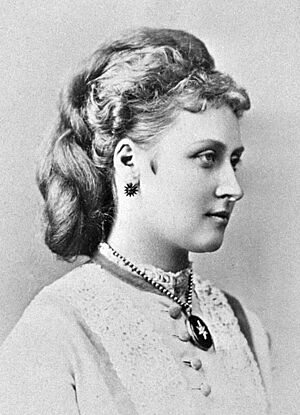
Alberta is named after Princess Louise Caroline Alberta. The province has a strong connection with the Canadian Royal Family. Many places in Alberta are named after royals, like Lake Louise and Queen Elizabeth II Highway.
The first king to visit Alberta was King George VI in 1939. The Lieutenant Governor of Alberta lives in Edmonton and represents the King in the province. The current Lieutenant Governor is Salma Lakhani. Charles, Prince of Wales (now King Charles III) first visited Alberta in 1977. Queen Elizabeth II visited Alberta six times, including in 2005 to celebrate Alberta's 100th birthday. Many other members of the Royal Family have spent time in Alberta. For example, Edward, Prince of Wales (who later became King Edward VIII) owned a ranch south of Calgary from 1919 to 1962.
Museums and galleries
Museums
Alberta's main museum is the Royal Alberta Museum in Edmonton. It opened in 1967 and has collections about life science, earth science, and human history. In 2005, Queen Elizabeth II gave the museum its "Royal" title. In 2018, the museum moved to a new building downtown.
Calgary's largest museum is the Glenbow Museum, which has a wide range of local and international objects. One of Alberta's most unique attractions is the Royal Tyrrell Museum of Palaeontology in Drumheller, which is famous for its dinosaur fossils. The Reynolds-Alberta Museum in Wetaskiwin has one of the world's largest collections of working machines. The Whyte Museum in Banff focuses on art and artifacts related to the Rocky Mountains. There are also several aviation museums, like the Bomber Command Museum of Canada in Nanton, and sports museums, like Canada's Sports Hall of Fame in Calgary.
Galleries
The province's largest art gallery is the Art Gallery of Alberta in Edmonton. It started in 1924 as the Edmonton Museum of Arts. In 2005, it moved to a new building and changed its name. The Southern Alberta Art Gallery in Lethbridge, which opened in 1976, is known for showing modern art. Other smaller galleries include the Nickle Galleries at the University of Calgary.
Festivals
Alberta's two biggest festivals are the annual events in Calgary and Edmonton: the Calgary Stampede and Klondike Days. Both of these events attract thousands of visitors from all over the world.
Alberta also hosts many film festivals, such as the Edmonton International Film Festival and the Calgary International Film Festival. Music lovers can enjoy festivals like the Calgary Folk Music Festival, Edmonton Folk Music Festival, and the Edmonton International Jazz Festival. For theatre fans, there's the Edmonton International Fringe Festival and The Canadian Badlands Passion Play.


